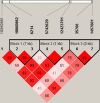Association of insulin-like growth factor-1 polymorphisms with high myopia in the Chinese population
- PMID: 22509095
- PMCID: PMC3324364
Association of insulin-like growth factor-1 polymorphisms with high myopia in the Chinese population
Abstract
Purpose: The purpose of this study was to determine whether genetic variants in the insulin-like growth factor-1 (IGF-1) gene were associated with high myopia in the Chinese population.
Methods: A case-control association study of 421 unrelated Chinese patients with high myopia and 401 control subjects matched in ethnicity and gender was undertaken. Genomic DNA was prepared from peripheral blood. All individuals were genotyped for 7 tag single nucleotide polymorphisms (tSNPs) across the IGF-1 gene region. Genotypic distribution was tested for Hardy-Weinberg equilibrium. The genotype and allele frequencies were evaluated using the χ(2) tests. Bonferroni corrections for multiple comparisons were performed.
Results: The polymorphism of rs12423791 showed positive association with extreme myopia (p(allel)=0.006 and p(allel1 recessive model)=0.004, respectively) after Bonferroni correction for multiple testing and the haplotype GC of rs5742629-rs12423791 was also associated with extreme myopia (p=0.033) after 50,000 permutations for multiple comparisons.
Conclusions: The polymorphism of rs12423791 in IGF-1 may be associated with extreme myopia in the Chinese population and should be investigated further.
Figures

Similar articles
-
[Association study of insulin-like growth factor-1 polymorphisms with extreme high myopia].Zhonghua Yan Ke Za Zhi. 2013 Apr;49(4):334-9. Zhonghua Yan Ke Za Zhi. 2013. PMID: 23900093 Chinese.
-
Association of IGF1 gene haplotypes with high myopia in Chinese adults.Arch Ophthalmol. 2012 Feb;130(2):209-16. doi: 10.1001/archophthalmol.2011.365. Arch Ophthalmol. 2012. PMID: 22332214
-
Association of IGF1 and IGF1R gene polymorphisms with high myopia in a Han Chinese population.Ophthalmic Genet. 2017 Mar-Apr;38(2):122-126. doi: 10.3109/13816810.2016.1145699. Epub 2016 Apr 4. Ophthalmic Genet. 2017. PMID: 27044882
-
IGF-1 gene polymorphisms in Polish families with high-grade myopia.Mol Vis. 2011;17:2428-39. Epub 2011 Sep 21. Mol Vis. 2011. PMID: 21976954 Free PMC article.
-
The G allele of the IGF1 rs2162679 SNP is a potential protective factor for any myopia: Updated systematic review and meta-analysis.PLoS One. 2022 Jul 21;17(7):e0271809. doi: 10.1371/journal.pone.0271809. eCollection 2022. PLoS One. 2022. PMID: 35862416 Free PMC article.
Cited by
-
Insight into the molecular genetics of myopia.Mol Vis. 2017 Dec 31;23:1048-1080. eCollection 2017. Mol Vis. 2017. PMID: 29386878 Free PMC article. Review.
-
Selective Ablation of Megalin in the Retinal Pigment Epithelium Results in Megaophthalmos, Macromelanosome Formation and Severe Retina Degeneration.Invest Ophthalmol Vis Sci. 2019 Jan 2;60(1):322-330. doi: 10.1167/iovs.18-25667. Invest Ophthalmol Vis Sci. 2019. PMID: 30665232 Free PMC article.
-
Probability of myopia in children with high refined carbohydrates consumption in France.BMC Ophthalmol. 2020 Aug 18;20(1):337. doi: 10.1186/s12886-020-01602-x. BMC Ophthalmol. 2020. PMID: 32811458 Free PMC article.
-
HOXA9 is a novel myopia risk gene.BMC Ophthalmol. 2019 Jan 23;19(1):28. doi: 10.1186/s12886-019-1038-9. BMC Ophthalmol. 2019. PMID: 30674274 Free PMC article.
-
Insulin-like growth factor 1 is not associated with high myopia in a large Japanese cohort.Mol Vis. 2013 May 21;19:1074-81. Print 2013. Mol Vis. 2013. PMID: 23734076 Free PMC article.
References
-
- Katz J, Tielsch JM, Sommer A. Prevalence and risk factors for refractive errors in an adult inner city population. Invest Ophthalmol Vis Sci. 1997;38:334–40. - PubMed
-
- Wong TY, Foster PJ, Hee J, Ng TP, Tielsch JM, Chew SJ, Johnson GJ, Seah SK. Prevalence and risk factors for refractive errors in adult Chinese in Singapore. Invest Ophthalmol Vis Sci. 2000;41:2486–94. - PubMed
-
- Xinhua News Agency. Available from: http://news.xinhuanet.com/politics/2010-01/03/content_12745349.htm
-
- Paluru P, Ronan SM, Heon E, Devoto M, Wildenberg SC, Scavello G, Holleschau A, Mäkitie O, Cole WG, King RA, Young TL. New locus for autosomal dominant high myopia maps to the long arm of chromosome 17. Invest Ophthalmol Vis Sci. 2003;44:1830–6. - PubMed
-
- Hosaka A. Population studies-myopia experience in Japan. Acta Ophthalmol Suppl. 1988;185:37–40. - PubMed
Publication types
MeSH terms
Substances
LinkOut - more resources
Full Text Sources
Miscellaneous
